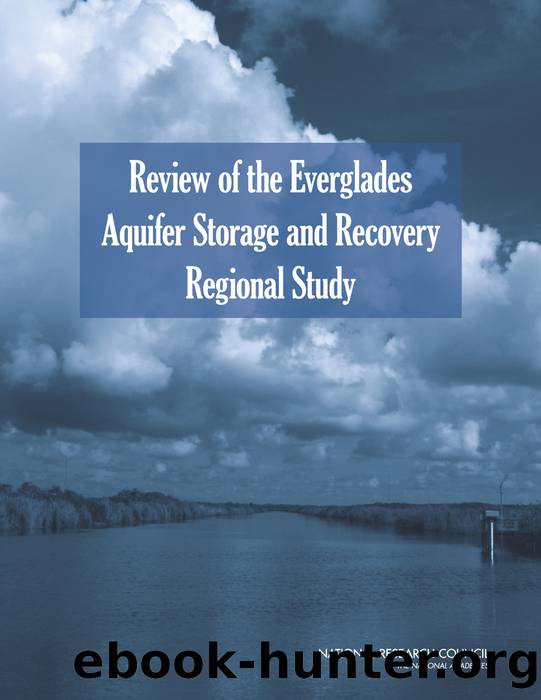Review of the Everglades Aquifer Storage and Recovery Regional Study by Committee to Review the Florida Aquifer Storage & Recover Regional Study Technical Data Report

Author:Committee to Review the Florida Aquifer Storage & Recover Regional Study Technical Data Report
Language: eng
Format: epub
Tags: ebook, book
Publisher: The National Academies Press
Published: 2015-06-16T00:00:00+00:00
FIGURE 2-2 A simplified conceptual diagram showing the methylation of mercury in response to varying surface water (sw) sulfate concentrations. At low concentrations of sulfate, increasing sulfate leads to increasing methylation. At higher sulfate (and sulfide) concentrations, methylation is inhibited. This figure does not consider additional factors associated with dissolved organic matter (Graham et al., 2013).
SOURCE: Modified from Gilmour et al. (2009).
The Regional Study provided some preliminary modeling to explore how increased sulfate could affect mercury methylation in Lake Okeechobee and the Everglades, but uncertainties remain. The Regional Study describes the impact of ASR-derived sulfate as âminimalâ relative to other sources (e.g., agriculture), but small (< 5 mg/L) shifts in sulfate have the potential to significantly increase mercury methylation if those areas are sulfate limited (Gabriel et al., 2014; see also Figure 2-2). For example, the area in western Water Conservation Area 3A projected by the Regional Study simulations to experience the greatest increases in sulfate concentrations under worst-case conditions (Figure 8-18 in USACE and SFWMD, 2014) is a region that Sheidt and Kalla (2007) reported to have low sulfate concentrations. The Regional Study correctly notes that increasing sulfate may inhibit methylation in some areas (e.g., Lake Okeechobee) while increasing it in others (e.g., Everglades), but no information is provided to document the relative change in methylation potential over time across the Everglades with ASR. More work is needed to model the anticipated changes in mercury methylation with increased sulfate loading in the Everglades, considering a range of probable ASR implementation and operational scenarios. Additionally, further study on temporal and spatial variability in sulfate and mercury methylation dynamics in Lake Okeechobee is warranted.
With regard to the fate of mercury in the subsurface, the laboratory experiments using crushed aquifer rock are useful to demonstrate the concept of subsurface mercury removal, but the results cannot be quantitatively extrapolated to actual well operation. Although ASR test data similarly showed a decline in mercury in recovered water compared to surface water, the Regional ASR TDR recommended further study on the mechanisms of mercury sequestration âbefore results from the current test wells can be extrapolated to other locations with any degree of certainty.â It is likely that water-surface interactions could vary from well to well based on native groundwater quality, aquifer and confining-unit characteristics, and ASR operational conditions.
Phosphorus
Phosphorus is a major contaminant in the Everglades ecosystem, which developed under oligotrophic (low-nutrient) conditions. Phosphorus inputs from many decades of agricultural activities have altered the remnant ecosystem, reducing the density and extent of periphyton communities (a key component of the food chain) and replacing areas of sawgrass with dense stands of cattail (NRC, 2012). A 1992 Consent Decree9 ultimately led to the development of a 10 ppb-phosphorus criterion for the Everglades Protection Area and large state expenditures on water quality treatment and source control. Today, water quality remains a major constraint for moving new water into the remnant Everglades, because without additional treatment systems the added water could lead to a violation of the Consent Decree. Phosphorus
Download
This site does not store any files on its server. We only index and link to content provided by other sites. Please contact the content providers to delete copyright contents if any and email us, we'll remove relevant links or contents immediately.
Whiskies Galore by Ian Buxton(41720)
Introduction to Aircraft Design (Cambridge Aerospace Series) by John P. Fielding(33017)
Small Unmanned Fixed-wing Aircraft Design by Andrew J. Keane Andras Sobester James P. Scanlan & András Sóbester & James P. Scanlan(32685)
Aircraft Design of WWII: A Sketchbook by Lockheed Aircraft Corporation(32163)
Craft Beer for the Homebrewer by Michael Agnew(18082)
Turbulence by E. J. Noyes(7895)
The Complete Stick Figure Physics Tutorials by Allen Sarah(7265)
The Institute by Stephen King(6860)
Kaplan MCAT General Chemistry Review by Kaplan(6823)
The Thirst by Nesbo Jo(6759)
Bad Blood by John Carreyrou(6477)
Modelling of Convective Heat and Mass Transfer in Rotating Flows by Igor V. Shevchuk(6354)
Learning SQL by Alan Beaulieu(6159)
Weapons of Math Destruction by Cathy O'Neil(6085)
Man-made Catastrophes and Risk Information Concealment by Dmitry Chernov & Didier Sornette(5878)
Permanent Record by Edward Snowden(5682)
Digital Minimalism by Cal Newport;(5588)
Life 3.0: Being Human in the Age of Artificial Intelligence by Tegmark Max(5405)
iGen by Jean M. Twenge(5326)
